Cheating in the evaluation. An expedient to estimate the impact of intangibles on the enterprise value of the high-growth start-ups
Titolo Rivista MANAGEMENT CONTROL
Autori/Curatori Giulia Cattafi, Giovanna Mariani, Francesco Pistolesi, Domenico Nicolò
Anno di pubblicazione 2024 Fascicolo 2023/3
Lingua Inglese Numero pagine 26 P. 193-218 Dimensione file 346 KB
DOI 10.3280/MACO2023-003009
Il DOI è il codice a barre della proprietà intellettuale: per saperne di più
clicca qui
Qui sotto puoi vedere in anteprima la prima pagina di questo articolo.
Se questo articolo ti interessa, lo puoi acquistare (e scaricare in formato pdf) seguendo le facili indicazioni per acquistare il download credit. Acquista Download Credits per scaricare questo Articolo in formato PDF

FrancoAngeli è membro della Publishers International Linking Association, Inc (PILA)associazione indipendente e non profit per facilitare (attraverso i servizi tecnologici implementati da CrossRef.org) l’accesso degli studiosi ai contenuti digitali nelle pubblicazioni professionali e scientifiche
This study investigates the effect of investments in intangible fixed assets and human capital on the Enterprise Value (EV) of Italian high-growth startups (HGSs). To test our hypotheses, we conducted several Ordinary Least Squares (OLS) regression analyses on a dataset comprising 782 HGSs. The EV was esti-mates using the Discounted Cash Flow (DCF) method. Our findings reveal a posi-tive and statistically significant relationship between investments in intangible as-sets and EV. However, investments in human capital and highly skilled workers show a negatively relationship with EV. Lastly, a positive and statistically signifi-cant relationship between value-added per employees and the EV of HGSs has been identified. This study offers valuable insight into the process through which new firms gener-ate value. By strategically investing in intangible assets and human capital, startups not only enhance their probability of survival but also improve their growth potential. This allows these companies to overcome the challenges of the early stage and embark on a sustainable growth process. To spotlight the unique value drivers of these companies, unlike prior studies, we manually estimate the EV. We have employed the DCF method by playing the cards face up: we used the actual cash flows realized by the HGSs during the study period instead of rely-ing on forecasts. We have therefore “cheated” to measure the value created by the HGSs. This research can be considered a pioneering study that significantly con-tributes to the ongoing debate on the value creation process in fast growing startups.
Parole chiave:High-growth firms, High-growth start-ups, Intangibles, Firm growth, Value creation, Human capital
- Startups and Gazelle Enterprises Massimo Contrafatto, Elbano de Nuccio, Domenico Nicolò, Matteo Pozzoli, pp.27 (ISBN:978-3-031-90880-4)
- Mutual Spatial Proximity, Organized Crime, and the Profitability of High-Growth Startups: The Case of Italian Gazelle Enterprises Carlo Migliardo, Domenico Nicolò, in MANAGEMENT CONTROL 1/2025 pp.237
DOI: 10.3280/MACO2025-001011 - Startups and Gazelle Enterprises Domenico Nicolò, Bruno Ricca, pp.151 (ISBN:978-3-031-90880-4)
Giulia Cattafi, Giovanna Mariani, Francesco Pistolesi, Domenico Nicolò, Cheating in the evaluation. An expedient to estimate the impact of intangibles on the enterprise value of the high-growth start-ups in "MANAGEMENT CONTROL" 3/2023, pp 193-218, DOI: 10.3280/MACO2023-003009